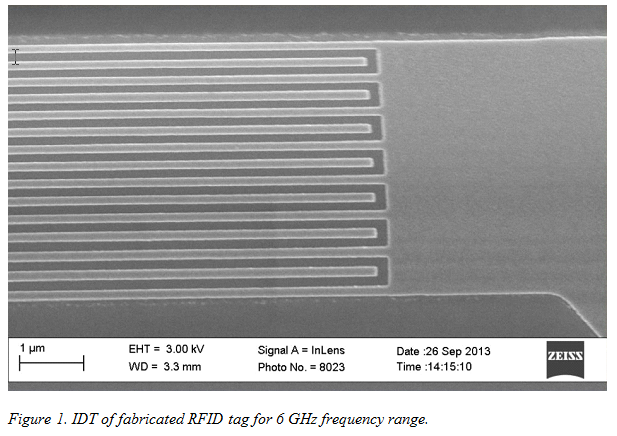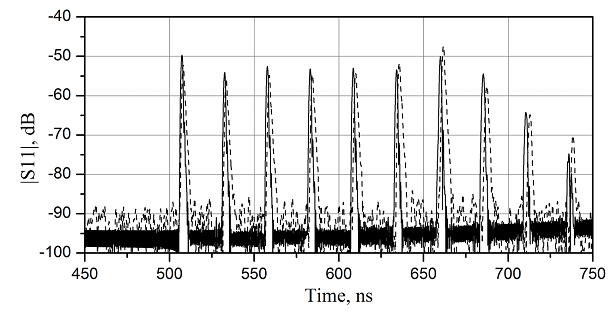«Poster report»
OF THE REPORT:
S. Suchkov, S. Yankin, D. Suchkov, V. Nikolaevcev, I. Shatrova, S. Nikitov
Sergey Yankin
REDUCE OF SIGNAL LOSSES IN MICROWAVE RADIO FREQUENCY IDENTIFICATION TAGS
Passive radiofrequency identification (RFID) tags that are used surface acoustic waves (SAW) and the RFID systems on its base become widespread throughout the world for the automatic control and accounting of transported and stored industrial goods, equipment, transport containers, and so on [1].
Currently, the demand for RFID tags using the new allowed frequency range 565 -6425 MHz [2] increases. That range gives the possibility to use up to nine times greater bandwidth than the ISM band (2.45 GHz), which allows to increase the data capacity, reduce the size of the tag at preserving identification range, and besides, in this range influence of industrial and domestic interferences (noses) are considerably less. Furthermore, an advantage of this frequency range is significantly smaller influence of industrial and domestic interference. However, in this very high frequency range informative signals (a sequence of code pulses) losses are significantly increasing, hindering the technical implementation of such RFID system.
This work examines the loss of informative signal SAW RFID tag in the 6 GHz frequency band and discusses the opportunities to reduce these losses. The most common structure of SAW RFID tag is considered. It consisted from bidirectional interdigital transducer (IDT) and signal reflectors located on one side of IDT [1].
Calculation of topological parameters and electrical characteristics was performed, taking in account real geometry of electrodes [3, 4], distinction between elastic parameters of thin film and volumetric metal electrodes [5] and SAW scattering into bulk modes [6-9] that it is necessary to align the amplitudes of the reflected (coded) pulses. High accuracy was achieved by using a combination of the finite and boundary element methods.
Experimental samples had the test topology with equidistant arrangement of signal reflectors located at 1mm distance from IDT that gave the initial time delay of .5 µs. Metalized structures were made from aluminum and were fabricated using electron beam lithography. State of art electron beam lithography system CRESTEC CABL-9 C was used to carry out lithography process. Electrodes and line reflectors had the width of about 15 nm and a thickness of 4 nm.
Image of fabricated test device’s IDT was obtained via scanning electron microscope (SEM) and is presented on Figure 1.

That time responses with code signals, formed by reflector’s systems for one of fabricated devices are shown on Figure 2. For comparison results of finite element analisys is demonstrated on the same figure.

It is clearly notable that coded pulses in experiment are smaller on 1-2 dB than theoretical response for the case of thin aluminum electrodes. That fact can be explained by discrepancy in real propagation losses for used piezoelectric substrates and those taken for modeling.
Level of code pulse’s amplitudes (-55 dB minimum) is close to the limit of technical implementation. Therefore, in this high frequency range, it is desirable to use other structures that can reduce losses of code signals. Reducing of the information signal loss can be achieved by using the properties of IDT bidirectionality and arrangement reflectors on each side of it, wherein the code signal amplitude can be increased up to 6 dB.
Additional reducing of the losses can be achieved using much shorter duration pulse coding, smaller distance between the reflectors and careful numerical design [3].
This work was supported by the following Grants: №11.G34.31. 3 (the Government of the Russian Federation) and co-joint PhD scholarship grant of the French Ministry of Foreign Affairs (French Embassy in Russian Federation).
References:
• Plessky V., Reindl L. Review on SAW RFID Tags//IEEE Trans. UFFC, vol.57, №.3. Р.654, 2 1 .
• Ministry of communications of Russian Federation, “Decision by State Committee on radio frequencies No 1 - 7- 2,” unpublished, 2 2.
• Sveshnikov B.V., Suchkov S.G., Yankin S.S. etal. Feasibility of SAW tag in 6 GHz frequency band// Proc. Conf. 2 13 IEEE International Ultrasonics Simposium, Prague, Czech Republic, 21-25 July 2 13, Prague: IEEE, 2 13.
• Osetrov A., So N. Calculation of the parameters of surface acoustic waves in piezoelectrics using the finite element method// Computational continuum mechanics, vol. 4, №4, P. 71, 2 11.
• Suchkov S., Barinov D. The anisotropy of thin metal films and its effect on the characteristics of SAW devices// Journal of Communications Technology and Electronics, vol. 47, №4, P. 458, 2 2.
• Graczykowski B. The reflection of Rayleigh surface waves from single steps and grooves//J. Appl. Phys., V.112, 1 352 , 2 12.
• Suchkov S.G., Yankin S.S., Nikitov S.A. et al. Propagation and reflection of surface acoustic waves in the system of topographic irregularities comparable with the wavelength//Proc. Conf. 2 13 International Congress on Ultrasonics, Singapore, 2-5 May 2 13, Singapore: Research Publishing, 2 13.
• Harma S., Plessky V. Extraction of frequency-dependant reflection, transmission and scattering parameters for short metal reflectors from FEM-BEM simulations//IEEE Trans. UFFC, vol. 55, № 4, P. 883, 2 8.
• Suchkov S., Yankin S., Nikitov S., Shatrova I. Scattering of surface acoustic waves by a system of topological irregularities comparable to the wavelength// Journal of Communications Technology and Electronics, vol. 59, № 4, P. 373, 2 14.